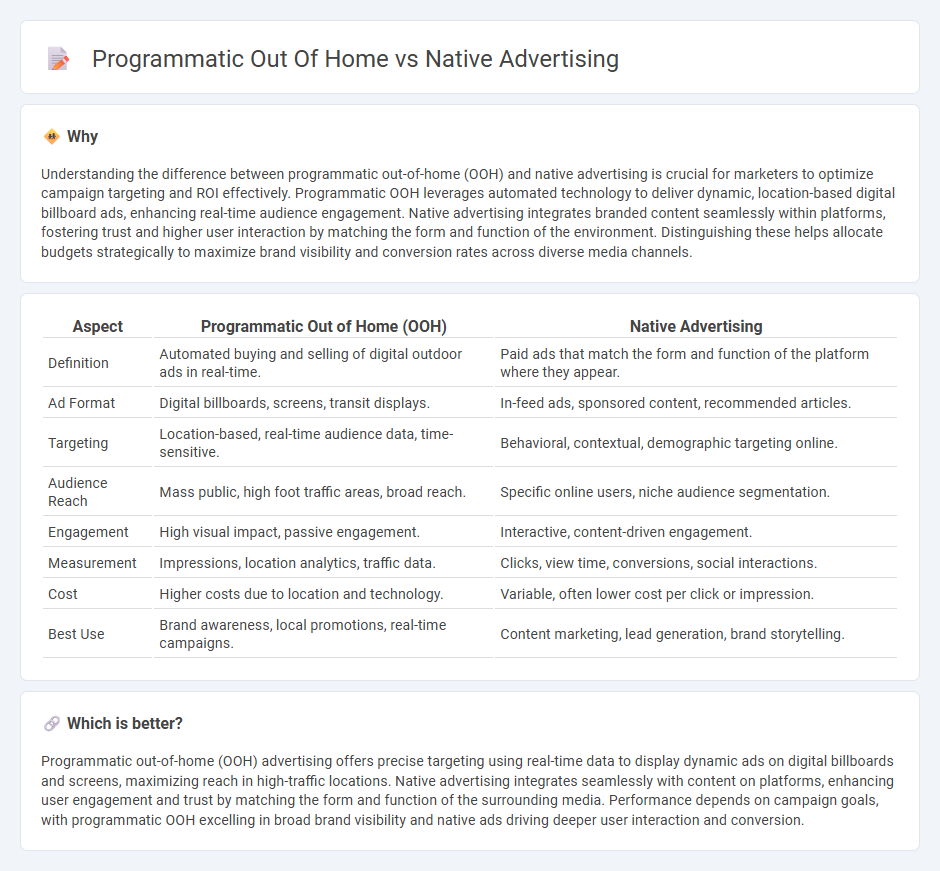
Programmatic out of home (OOH) advertising uses automated technology to buy and display digital billboard ads in real-time, enabling precise targeting based on location and audience data. Native advertising integrates sponsored content seamlessly within digital platforms, matching the form and function of the user experience to improve engagement and brand perception. Explore how combining programmatic OOH with native advertising strategies can maximize marketing impact and ROI.
Why it is important
Understanding the difference between programmatic out-of-home (OOH) and native advertising is crucial for marketers to optimize campaign targeting and ROI effectively. Programmatic OOH leverages automated technology to deliver dynamic, location-based digital billboard ads, enhancing real-time audience engagement. Native advertising integrates branded content seamlessly within platforms, fostering trust and higher user interaction by matching the form and function of the environment. Distinguishing these helps allocate budgets strategically to maximize brand visibility and conversion rates across diverse media channels.
Comparison Table
| Aspect | Programmatic Out of Home (OOH) | Native Advertising |
|---|---|---|
| Definition | Automated buying and selling of digital outdoor ads in real-time. | Paid ads that match the form and function of the platform where they appear. |
| Ad Format | Digital billboards, screens, transit displays. | In-feed ads, sponsored content, recommended articles. |
| Targeting | Location-based, real-time audience data, time-sensitive. | Behavioral, contextual, demographic targeting online. |
| Audience Reach | Mass public, high foot traffic areas, broad reach. | Specific online users, niche audience segmentation. |
| Engagement | High visual impact, passive engagement. | Interactive, content-driven engagement. |
| Measurement | Impressions, location analytics, traffic data. | Clicks, view time, conversions, social interactions. |
| Cost | Higher costs due to location and technology. | Variable, often lower cost per click or impression. |
| Best Use | Brand awareness, local promotions, real-time campaigns. | Content marketing, lead generation, brand storytelling. |
Which is better?
Programmatic out-of-home (OOH) advertising offers precise targeting using real-time data to display dynamic ads on digital billboards and screens, maximizing reach in high-traffic locations. Native advertising integrates seamlessly with content on platforms, enhancing user engagement and trust by matching the form and function of the surrounding media. Performance depends on campaign goals, with programmatic OOH excelling in broad brand visibility and native ads driving deeper user interaction and conversion.
Connection
Programmatic out-of-home (OOH) and native advertising are connected through their shared reliance on data-driven technology to deliver personalized and contextually relevant messages to specific audiences. Both leverage real-time data analytics and algorithmic buying to optimize ad placements and enhance consumer engagement across digital and physical environments. This integration maximizes marketing efficiency by combining the immersive nature of native content with the dynamic reach of programmatic OOH displays.
Key Terms
Contextual Integration
Native advertising excels in contextual integration by seamlessly blending promotional content within relevant editorial environments, enhancing user engagement and brand recall. Programmatic out-of-home advertising leverages real-time data and location-based targeting to deliver contextually appropriate ads on digital billboards and screens, optimizing audience reach and message relevance. Explore deeper insights on the strengths of contextual integration in both advertising strategies.
Automated Buying
Native advertising integrates seamlessly within digital content to engage audiences, while programmatic out-of-home (OOH) leverages automated buying to display dynamic ads on physical billboards and screens in real time. Automated buying in programmatic OOH optimizes ad placement and targeting using data-driven algorithms, enhancing campaign efficiency and audience reach beyond traditional native ad placements. Explore how automated programmatic buying revolutionizes OOH advertising strategies and delivers measurable impact.
Audience Targeting
Native advertising leverages contextual relevance and user behavior data to seamlessly blend promotional content within editorial environments, enhancing engagement by targeting users based on browsing patterns and interests. Programmatic Out of Home (OOH) uses real-time data such as location, time, and audience demographics to dynamically deliver ads on digital billboards and screens, maximizing reach through automated, hyper-local targeting. Discover how these advanced audience targeting techniques can elevate your marketing strategy by exploring their distinct advantages.
Source and External Links
What is Native Advertising - How it Works - Outbrain - Native advertising is a form of paid advertising where ads match the look, feel, and function of the media format where they appear, providing a high-engagement promotional experience that blends with editorial content.
What is native advertising? - Adjust - Native advertising is paid media designed to match the content of a media source, offering non-intrusive, relevant ads that fit into the user's browsing experience and deliver higher engagement and conversion rates than traditional ads.
Native Advertising: How It Works, Types, Benefits - Taboola.com - Native advertising is a paid media approach where ads blend seamlessly into the platform's content and format, making them an accessible and effective strategy for nearly all types of businesses seeking to reach targeted audiences.
 dowidth.com
dowidth.com